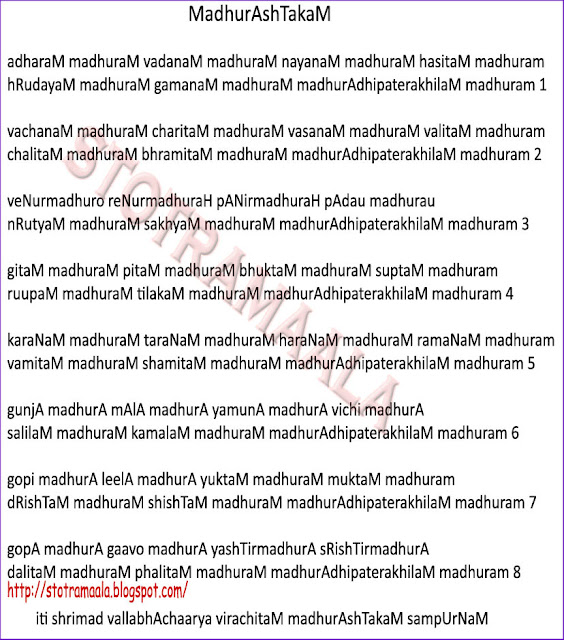‘Ashta’
or eight is a recurring number that connects with abundance and power. In
mathematics it is the first cubed number(2×2×2=8). This pattern of Tihai,
Trimurthi or Tridevi is again prevalent in Indian art . Eight as the number for
abundance is depicted through the ashta laxmi. The ashta disha and their guardians (digpala)
as well as the ashtavinayakas are other occurrences of a power split
among eight deities. In Mahayana buddhishm, we see the eightfold path of gyana
while Patanjali describes the eightfold astanga marg of yog.

In Kathak, we see dance representations of
the ashtakam as well as ashtapadi. The ashtakam is a ‘stuti’
or composition comprising of eight stanzas that are written in praise of a
specific diety. For example ‘Champeya Gaurardha
SharirakayaiKarpura Gaurardha Sharirakaya’ (one whose
body shines similar to molten gold, one whose body shines like the burning
camphor),are the opening lines of the popular ardhanareeshwara
stotram, an ashtakam written by Adi Shankaracharya (8 C.E), who
is one of the best known ashtakamwriters. Similarly another popular ashtakam
is the Madhurastakam written by Vallabhacharya(15 C.E) that describes
the beauty in every aspect of lord Krishna. One should note that in the
traditional recitation of the astakam the recital moves forth in linearity from
start to end. There is no ‘signature line’ or ‘sthayi’ line that is
repeated. But within the stanzas themselves we may see a repitition of words, as seen in the madhurastakam (akhilam madhuram) or shivastakam (Shankaram Shambhumishanamidhe)

In the following video we see Abhinaya Queen of Kathak, Saswati Sen present the Madhurastakam sung, composed and choreographed by Pt Birju Maharaj
On the other hand the ashtapadi
meaning eight steps comes to fore due to Jaydeva(12 C.E.), whose
giti-kavya the ‘Gita Govinda’ heralds the bhakti movement in
India. Jayadeva wrote his astapadi composition in eight sections, and each has
been designed as a conversation between any two of the central
characters-Radha, Krishna and Sakhi. The difference we see from the astakam
format is that Jayadeva gives a ‘dhruva’ line that can be used as the ‘sthayi’
line of the astapadi. For example
in the astapadi, Lalitha lavanga lata pari sheelana, komala Malaya sameere (
the cool breeze of spring carries the fragrance of the clove bushes), the
dhruva line ‘viharati haririha sarasa vasante nrutyati,yuvati janena samam
sakhi virahi janasya durante’ (Krishna is dancing with the gopis in the
beautiful spring, come let us go to him as we are pining in love for him), is
recited or sung after every stanza. This brings forth the central theme of the astapadi
which is the Sakhi describing Krishna’s exploits to Radha and urging her to go
to Krishna. This same concept we see being used in the popular ashtapadi
by Pt Bindadin Maharaj which describes the lakshanas of Kathak – ‘Niratata
dhang ang Sudhang’. Each stanza describes the various imageries of the
dancing Krishna with the recurring refrain of ‘Niratata Dhang’. The following video is a choreography by Kathak exponent Shambhavi Dandekar ji on this eternal composition.
We see an influence of the Astachaap on this work by Pt Bindadin Maharaj. The disciples of Vallabhacharya, the eight Astachaap poets are truly responsible for establishing the path of bhakti through Hari shringara. According
to Vallabha tradition, one night in 1494, Vallabhacharya received the Brahmasambandha mantra (the mantra that binds one with Brahman, or Krishna) from Krishna
himself
(mukhāvatāra) at Gokula.
The eight-syllable mantra, śri kṛṣṇaḥ śaraṇaṃ mama (Lord
Krishna is my refuge), is passed onto new initiates in Vallabh sampradaya, and
the divine name is said to rid the recipient of all impurities of the soul (doṣas) . Vallabhacharya expounded the principle of
pure non duality or shudda adwaita. The brahman and the soul are but one and
realization of Krishna is also equivalent of self-relaization. Here we see the interrelation of the '2' and '8'. An astapadi that truly moves me is ' Shri Nand Nandan Nachat Sudhang' by Surdas, the most acclaimed of the ashtachaap poets. In the below video we see Kathak Exponent Rani Khanam ji beautifully presenting this through a beautiful choreography.





